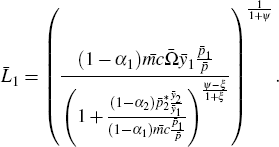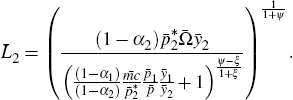RDP 2013-07: An Empirical BVAR-DSGE Model of the Australian Economy Appendix B: Steady State
June 2013 – ISSN 1320-7229 (Print), ISSN 1448-5109 (Online)
- Download the Paper 658KB
Superscript bars denote steady state values. We log-linearise around a deterministic
steady state where the real exchange rate, ,
is normalised to 1, and net foreign assets equal 0. Also, real commodity prices
are exogenous to the small economy, so we set
,
is normalised to 1, and net foreign assets equal 0. Also, real commodity prices
are exogenous to the small economy, so we set  . Steady state inflation
is assumed to be 0. In this section we provide the details necessary to calculate
the steady state quantities which appear in the log-linearised model or were
used in calibration.
. Steady state inflation
is assumed to be 0. In this section we provide the details necessary to calculate
the steady state quantities which appear in the log-linearised model or were
used in calibration.
B.1 Cash Rate
In the steady state, from the consumer's first-order condition for bond holdings
 .
.
B.2 Prices
Import prices
In the steady state, retail import prices are a constant mark-up over nominal marginal costs (alternatively, real marginal costs are constant):
Note also that
Domestic good prices
From the expression for the CPI we have:
Using the expression for real import prices above, we obtain:
Real marginal costs in the domestic goods sector
Similar to import prices, we have
B.3 Investment
Domestic goods gross rental rate
Tobin's Q in steady state is 1. From the equation for Tobin's Q we can obtain:
Export sector gross rental rate
Similarly:
Capital to output ratio, domestic good sector
From the factor demand equation
Investment to output ratio, domestic good sector
From the capital accumulation equation
Capital to output ratio, export sector
Investment to output ratio, export sector
Note for the measurement equation for investment  ,
and that
,
and that  .
An expression for the
.
An expression for the  is developed below. We can then express
is developed below. We can then express  and
and  .
.
B.4 Trade
In steady state we have net foreign assets as a share of GDP equal to 0. This implies balanced trade. Further, we have
From which we can obtain:
Note that  ,
so we have
,
so we have
B.5 Consumption
Lagrange multiplier on the budget constraint
Imports
We have the following demand function:
Domestic goods
Similarly, for domestic goods.
Consumption share of domestic goods
From the market clearing for domestic goods we have:
From this we can obtain
B.6 Labour
Labour, domestic goods
From the labour supply of consumers we can obtain an expression for the labour share:
From the labour demand of firms we have
Equating these, and using results from above, we obtain:
Similarly,
These can be substituted into
B.7 Real Money Balances
Note that from money demand we have
The  can be obtained by rearranging the production function of domestic good firms to
be:
can be obtained by rearranging the production function of domestic good firms to
be:
As we have an expression for  above we can solve for
above we can solve for  , and hence
, and hence  .
.
B.8 Value added
In steady state we have
The coefficients in the log-linearised expression for value-added are:
and
The ratios to value added, such as those in the net foreign assets equation, can
easily be derived, e.g.  .
Similarly,
.
Similarly,  .
To determine the compensation of employees to nominal value added, i.e.
.
To determine the compensation of employees to nominal value added, i.e.  ,
which were used in the calibration but not in the steady state of the model,
the labour demand equations can be utilised, together with the previous expressions
for the share of value added constituted by each sector's output and relative
prices. In the domestic good sector
,
which were used in the calibration but not in the steady state of the model,
the labour demand equations can be utilised, together with the previous expressions
for the share of value added constituted by each sector's output and relative
prices. In the domestic good sector  and
and  . For the export sector
we have
. For the export sector
we have  .
.




























